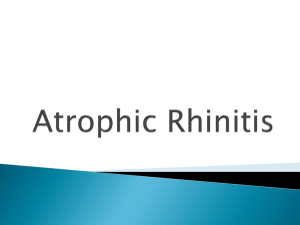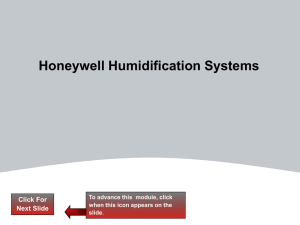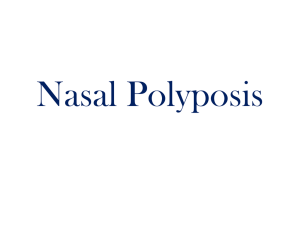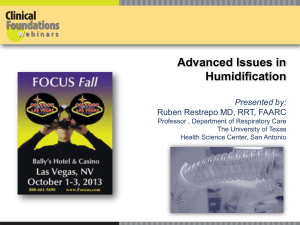Presentation Title
advertisement
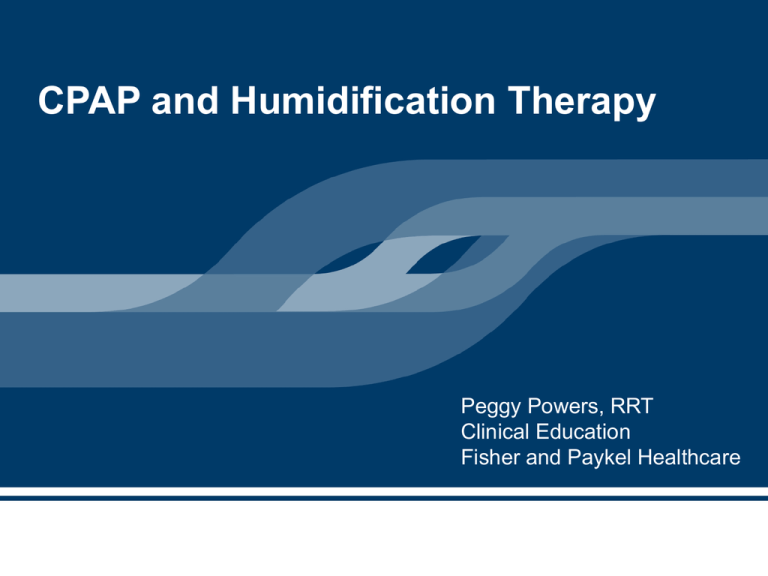
CPAP and Humidification Therapy Peggy Powers, RRT Clinical Education Fisher and Paykel Healthcare Conflict of Interest Disclosure(s) I do not have any potential conflicts of interest to disclose MY CPAP GAVE ME A COLD! Up to 75% of patients receiving CPAP therapy suffer from nasal congestion and upper airway congestion. Inhalation of cool dry air increases nasal congestion and causes inflammation, this accounts for the patient reporting “MY CPAP GAVE ME A COLD” Due to vascular reactivity of the turbinate’s and nasal congestion, nasal resistance may increase and the patient may present with: • Claustrophobia • Receiving inadequate airflow • Mouth breathing • Unconscious removal of the CPAP mask at night Environment Dusty house Cluttered house Pet dander Cold House Hot House Demographics/Climate • • • • • Desert Ocean Altitude Swamp Jungle Background to Humidification Background to Humidification What is Humidity? • Humidity is the amount of water vapor in a gas • Describing humidity – Absolute Humidity – Relative Humidity • Key humidity concepts – Maximum Capacity – Dew point Absolute Humidity (AH) 15 mg/L Absolute Humidity 30 mg/L Absolute Humidity 1L 15 mg 30 mg • mgH2O/L is usually referred to as mg/L Relative Humidity (RH) 50% Relative Humidity 100% Relative Humidity 1L 30 mg 30 mg 15 mg 30 • % = content/capacity x 100 Maximum Capacity 30 mg/L 27 mg/L 24 mg/L 22 mg/L 19 mg/L 17 mg/L 15 mg/L 18 ºC 20ºC 22 ºC 24 ºC 26 ºC 28 ºC 30 ºC Dew Point • The temperature at which water vapor begins to condense – Cooling process • Here, the gas is fully saturated i.e. 100% Relative Humidity Humidification & the Upper Airway Anatomy of the Airway •Gross anatomy of the airway •Three main regions: Naso-pharynx Oro-pharynx • Naso-pharynx • Oro-pharynx • Trachea Trachea Inspiration 22 °C Room Air 7 mg/L, 35% RH 31 °C Naso/Oropharynx 30 mg/L, 90% RH 36 °C Trachea 42 mg/L, 100% RH 37 °C Isothermic Saturation Boundary 44 mg/L, 100% RH Nasal Symptoms • The airway is a natural heated humidifier • A constant flow of air delivered via CPAP can dry the nasal mucosa • Excessive drying of the nasal mucosa increases nasal resistance, thereby increasing nasal discomfort • Production of mucus is also increased to help humidify the additional air flow • These factors can induce symptoms such as nasal congestion Nasal Congestion • Nasal congestion is a narrowing/blockage of the nasal passages • It is usually due to membranes lining the nose becoming swollen from inflamed blood vessels. • Nasal congestion is also known as nasal obstruction, blocked nose, runny nose, or stuffy nose. Nasal Symptoms • Nasal symptoms can be alleviated by the use of a humidifier with your CPAP • When the flow of air is already humidified this reduces the demand on the bodies natural humidification system Available Humidification Technologies Humidification Delivery Modes • No humidity • Cold pass-over • Conventional heated humidification • Heated breathing tube No Humidification CPAP treatment where no humidity is delivered to patients Effectively delivers ambient air Effects of No Humidification Nasal symptoms - dryness of nasal mucosa & nasal congestion Mouth leak Therapy abandonment Cold Pass-Over Humidification What is cold pass-over humidification? • Passing of cold air over water • An interim treatment for patients who complain of nasal symptoms after initiation of CPAP Effects of Cold Pass-over No clinical evidence available to support the use of cold pass-over Increase in nasal resistance on dry CPAP (no humidification) are unchanged with cold pass-over Mouth leak Therapy abandonment Conventional Heated Humidification What is conventional heated humidification? • Heating the water filled chamber using a heater plate • Air passing over the heated water adds moisture and humidifies the delivered air • Turbulence induced in the chamber helps pick up humidity Benefits of Conventional Heated Humidification 1. Alleviates reported nasal discomfort 2. Lowers therapy abandonment 3. Improves patient compliance 4. Reduces the incidence of mouth leak Limitations of Conventional Heated Humidification • Ambient air temperature • Condensation • Disruptive noise leading to fluctuating mask pressure Condensation – Conventional Humidification 30 oC 29 mg/L 20 oC 17 mg/L TUBE COOLING = CONDENSATION BUILD UP = PATIENT DISRUPTION Condensation Bacon et al, 2000 Heated Breathing Tube (HBT) What is the idea behind the heated breathing tube? • Copper wire coiled inside breathing tube • Discounts the effects of changing ambient temperature • Operates in its own controlled environment Conventional vs HBT Conventional Timeline 2hrs Conventional Humidification 30mg/L 18 mg/L TUBE COOLING - CONDENSATE FORMS Timeline 2hrs Heated Breathing Tube Humidification HBT 30mg/L 30mg/L WARM TUBE: HEAT LOSS + HEAT GAIN = CONSTANT HEAT HBT Clinically Proven for A Better Nights Sleep ThermoSmart™ THE ORIGINAL HEATED BREATHING TUBE • • • FPH 40 years of experience in humidification technology 5 years of global ThermoSmart™ market experience Dedicated research program Sensors & algorithms in place of RH and EOH sensors The sophisticated algorithm used means the results achieved by an end of hose RH sensor can be mimicked Different levels of RH are built into each ThermoSmart™ Boost setting F&P consistently delivers higher levels than both the SystemOne and S9 systems Proven Clinical Research Clinical Studies support the effectiveness of ThermoSmart™: • Nilius: improves sleep quality and total sleep time • Almasri: provides a more comfortable CPAP experience • Virag: eliminates condensation while delivering higher levels of absolute humidity • Massengill: lowers nasal airway resistance for 10% lower titration pressure HBT START WITH THERMOSMART™ Clinical Summary The addition of a heated breathing circuit to a delivery system: • Ensures stable gas temperatures • Allows for higher humidity levels to be delivered • Increased patient comfort and therefore compliance • Eliminates condensation • Ensures mask pressure stability • No sleep cycle disruptions from tubing noise End

